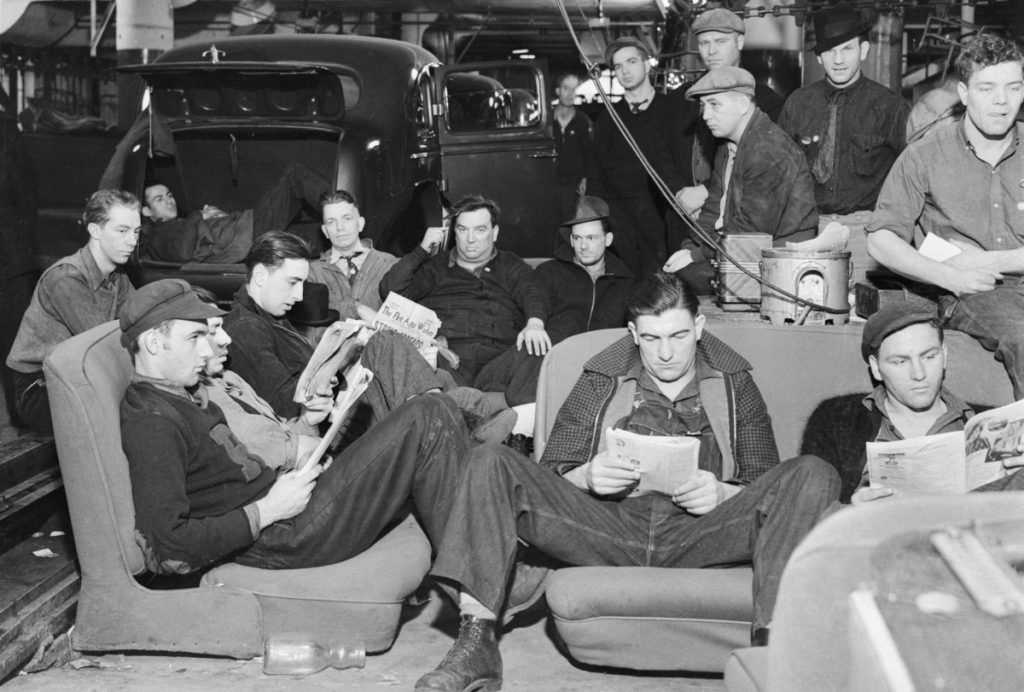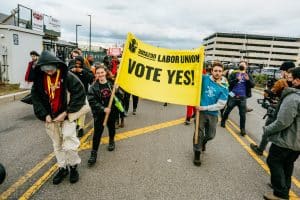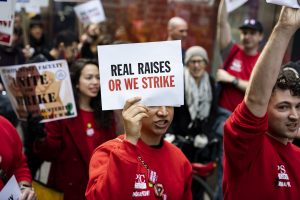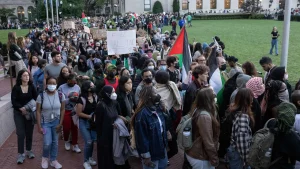When people picture the labor movement of the 1930s, one image that comes to mind is stern men sitting on car seat cushions reading the newspaper. They’re picturing the Flint sit-down strike. But not many know the details of the strike, or how exactly “sit-down!” became a rallying cry for millions of workers throughout the United States and solidified unions as powerful institutions in the country for decades. A tactic as simple as stopping work without leaving the workplace took on an almost mythical character. Autoworkers, who put together cars on a speeding assembly line with dangerous machines, violent foremen, and the ever-present threat of getting fired banded together and defeated the colossal General Motors Company. On the 84th anniversary of the start of their struggle, we remember those brave workers.
The History of a Tactic
The tactic of the sit-down strike was not invented in Flint, or even in the United States. There have been work stoppages, of course, ever since one group of people began telling another to work or starve, or worse. Likewise, the idea of stopping work and occupying the workplace is pretty old. In revolutionary periods under modern capitalism, workers took over factories as a natural outcome of overthrowing the social order, as they did in Russia, Hungary, and Germany in the late 1910s. And during the Red Years (1919-1920) in Italy, auto and metal factories were occupied even though the working class had not taken power. When revolution was not quite on the table, too, miners sat in at their mines throughout Europe, from Poland to Wales, in response to the ongoing Great Depression. Closer to home, rubber workers in Akron, Ohio went on short sit-down strikes in 1934.
More pertinent to Flint, a sit-down strike wave broke out in France in the summer of 1936, with 150,000 metalworkers taking control of their factories in the summer of 1936. As Michael Torigian outlined in “The Occupation of the Factories: Paris 1936, Flint 1937,” that was half the country’s metalworkers. In the weeks following and at the height of the movement, another nearly 2 million workers — or one quarter of France’s working class — joined them in either sit-downs of their own or in more typical strike fashion. From this, the working class in France won the Matignon Agreements, which legalized collective bargaining and strikes, established the 40-hour workweek and the two-week paid vacation, and raised wages by about 10 percent.
U.S. workers perhaps knew what was going on in France. Their bourgeois opponents definitely understood the ramifications for the world working class. During the Flint strike, Catholic bishops in Detroit denounced the “illegal sit-downs borrowed from the communists of France.”
Prologue
In November 1935, John L. Lewis — long-time president of the United Mine Workers of America (UMW) — founded the Committee of Industrial Organization within the American Federation of Labor (AFL). The idea was to push the AFL to organize the new millions of workers in the ever-growing factories, rather than just continuing to focus on the more skilled, craft-oriented parts of the class — a sector that was shrinking in size and power as the assembly line proliferated. The AFL needed that kick in the ass overall because it had taken a beating in the 1920s from an emboldened capitalist class and growing economy, a whooping that continued in the first years of the Great Depression, when capitalists were even more emboldened to cut wages on account of the 25 percent unemployment and growing poverty. Until the big strikes of 1934 in Toledo, San Francisco, Minneapolis, and throughout the textile industry, the working class was demoralized and aimed simply to survive; the AFL had circled the wagons and was doing very little to organize.
It was the experience of the 1934 strikes and a slightly improving economy that began to raise the confidence of the class and set the groundwork for the wave of sit-down strikes that began in the winter of 1936 with the actions of the United Auto Workers (UAW).
The UAW was born fighting. Because the fledgling union wanted to organize industrial workers — all the workers in a given factory, no matter their job, rather than along their specific job (craft) lines — the members had to fight within the AFL just to found their own international in 1935. At their second convention, the UAW went so far as to unanimously adopt a resolution for a labor party, which would be a huge advance for American workers. Further, a ban against communists proposed by conservative labor leaders within the union was rejected. Within two months, this more radical union was marginalized in the AFL and they joined the CIO, which was still technically within the AFL as the Committee of Industrial Organization before it became the Congress of Industrial Organization in 1938 as an entirely separate union federation.
As made very clear in the seminal Labor’s Giant Step by Art Preis, the CIO the UAW joined was an organization full of contradictions. It formed out of a progressive insistence to organize the “unskilled” and workers marginalized by the traditional labor movement, but many of its top leaders were still wedded to the idea of “peaceful coexistence” with the bosses. This attitude was manifested in its first major national campaign, which wasn’t union organizing at all but was about reelecting Pres. Franklin D. Roosevelt through the newly formed Labor’s Non-Partisan League (LNPL). The CIO’s second campaign was to organize steelworkers through the Steel Workers Organizing Committee (SWOC), and to do so with hundreds of organizers and closed-door discussions with U.S. Steel. The rank and file were to be led and, if possible kept on a leash. By contrast, the UAW — given its upbringing — was a union driven by the ranks. That driving factor helps explain the sit-down strikes.
The Strike Begins
Even before the sit-down strike began in earnest on December 30, 1936, auto workers were champing at the bit. In November, workers at Fisher Body Plant No. 1 in Flint had a short sit-down against the quicker pace of work caused by the “speed-up” — when the bosses sped up the assembly line to force greater productivity. When the workers beat that back, hundreds more joined the UAW. Since that single plant was the largest car body factory in the world, with its 7,000 workers producing 1,400 bodies a day for General Motors, it was a very big deal that they won. Over the weeks, there were strikes and occupations at Bendix, in South Bend, Indiana; Midland Steel Products and Kelsey-Hayes Wheels both in Detroit; and other Fisher Body Plants in Atlanta and Kansas.
By this time, CIO leadership had pivoted from SWOC to try to get in front of this rising tide of rank-and-file militancy, and Lewis and UAW President Homer Martin offered to meet with GM to negotiate some kind of agreement. Likely, this sort of meeting would have been similar to the secret ones Lewis was holding with U.S. Steel at around the same time. But GM refused to meet, insisting instead that the union take up the issues at the various plants separately. Against GM’s stalling actions, 7,000 workers struck and occupied Fisher Body in Cleveland, Ohio, on December 28, 1936 — two days before the big sit-down in Flint.
Fisher Body Plant No. 2, Then Everywhere
On December 30, 1936, workers at Fisher Body Plant No. 2 began a 44-day occupation of the factory that would launch a flood of class struggle that built the CIO and made the 1930s a shorthand phrase for militancy. The immediate cause was likely the disciplining of union supporters in the plant, but there are conflicting stories; nevertheless, the difficult conditions in the industry made action inevitable. In Sidney Fine’s history of the event, Sit-Down, the strike was two days premature, aimed to coincide with the more “pro-labor” governor Frank Murphy — who nonetheless owned tens of thousands of dollars in GM shares — taking office. However, as a rebellion from below, the exact start didn’t matter: workers were fired up and ready to fight.
That evening, more than 1,000 workers at the much larger Fisher Body Plant No. 1 joined in and took over the plant, spurred into action after they witnessed critical casting dies being prepared for shipment to other plants in anticipation of a labor disturbance. Although by this time only a tenth of Flint’s 43,000 auto workers had joined the UAW, union members had the support of their coworkers and were located in a keystone of GM manufacturing. The body factories in Flint and Cleveland made parts necessary for three-quarters of GM’s 69 plants in the United States.
As such, within three weeks, occupations or strikes shut down another 15 GM units in Flint, Detroit, Wisconsin, Ohio, Georgia, Missouri, and Kansas. Including both active participants and workers idled by the bottleneck, 140,000 of GM’s 150,000 production workers were off the job. Around $50 million worth of capital goods and property were tied up, and GM was making no money.
The tactic of taking over a factory is already a radical one, but it was inside the plants that there was a deeper politicization. Although they worked shoulder-to-shoulder, assembly-line workers were atomized by the pace and difficulty of their jobs. Suddenly, these men and women from many parts of the country, and from other countries as well, came together and had time to themselves. The actual running of the occupation required collective action to maintain supplies, morale, discipline, and cleanliness. Committees were organized to provide recreation and offer classes on various subjects. Socialist and communist workers spoke directly to others of their class who were experiencing struggle in real time. No longer appendages of machines, rank-and-file workers took the mantle as revolutionary subjects in history. That is clear in the interviews with workers in the BBC series Yesterday’s Witness in America.
Outside the plants, GM was haranguing Lewis and CIO leaders to end the occupation so there could be negotiations, but the bosses understood that they were not masters of the situation. At the plant gates, workers and supporters — especially from industries that had participated in earlier strikes — began to mobilize. On the streets, sound cars were utilized to lift the spirits of the strikers and bring news of the struggle to the community. Leftist women formed a Women’s Auxiliary, which had been used to great effect in the 1934 strikes, to convince the partners and relatives of strikers of the necessity of the fightback; the auxiliary raised funds, prepared food and supplies, and joined the picket lines.
On January 3, 1937, 200 UAW delegates convened to call a company-wide strike against GM and formulate eight demands: a signed contract and recognition of the UAW as the sole bargaining agent — as opposed to company unions legally promoted by many companies of the time; the abolition of piecework; a 30-hour workweek and six-hour day; time-and-a-half overtime pay; minimum pay rates; reinstatement of fired strikers; a seniority system; and a say for the union on the pace of the assembly line. Some of these demands resonated well beyond GM, especially “30 for 40” — the idea of a 30-hour workweek at no loss in pay, which would not only improve the lives of the currently employed immensely, but also lower unemployment by providing work for others. It is no accident that revolutionary Leon Trotsky, in The Transitional Program, puts the sliding scales of wages and hours — that is, the distribution of work to more people as productivity increases — as one of the key demands for the working class from the 1930s onward.
While all this was happening, GM were scheming to break the movement. On January 2, the bosses convinced a judge to issue an injunction against the sit-downers for violating property rights, although at the time it was an open question and the sit-down wouldn’t become an “illegal seizure” until a Supreme Court case in 1939. But when it was discovered that the judge held nearly 4,000 GM shares valued at more than $200,000, the injunction became difficult to enforce. Some days later, GM formed the Flint Alliance, led by an ex-mayor of the city, to drive a back-to-work movement made up of some workers who pledged to oppose the strike. It was against their efforts to sow confusion among families of strikers that the Women’s Auxiliary had its most difficult, but vital, responsibility.
Battle of the Running Bulls
The bosses’ next idea was to shut off heat to the factory and call on the police to besiege Fisher No 2. That happened on January 12, and would precipitate the “Battle of the Running Bulls.” When word of the siege got out, thousands of picketers called up by the UAW, the Women’s Auxiliary, and Left groups surrounded the police lines. They formed squares to rush the lines and break through with food and hot coffee, which was accomplished thanks to the thousands of supporters who showed up. The police regrouped and attacked with tear gas and buckshot, but workers in the plant responded with cold water from fire hoses and auto parts-cum-projectiles hurled at the police. The police retreated and numerous squad cars were taken as spoils — but at the cost of 24 injured strikers, 14 of whom were treated for gunshot wounds.
From the lessons of the battle, Genora Johnson Dollinger, a socialist leader of the Women’s Auxiliary who later became a Trotskyist, put together the Women’s Emergency Brigade to take up the more dangerous tasks in support of the sit-down. Wearing red berets and armbands and armed with clubs, they served as a sort of workers’ defense guard in the last weeks of the struggle. At its height, there were 400 members spread out in various cities. A documentary was filmed decades later on the contributions of the brigade.
Another consequence of the battle was that GM announced it would not attempt to break the occupation by force. The governor, who had been playing a behind-the-scenes role but understood the political cost of shooting strikers, tried to call a truce. Nearly a week later, it appeared that both sides would come to the negotiating table, but it was exposed that GM was plotting to bring in the Flint Alliance as a company union. Workers who were on their way out of the factories turned around, retook their positions, and settled in to continue the fight.
The Strike Continues Until Victory
In late January 1937, Roosevelt entered the scene. Although Lewis, ever the FDR partisan whose LNPL raised hundreds of thousands of dollars for his reelection, asked the president directly in a press conference to come out in favor of the workers, the answer was a stern no. The administration’s solution was that workers should end the occupation “as an expression by the union of good faith” before negotiations could begin.
Fortunately, rank-and-file unionists were not as naive as their top leadership, and they declined to leave. Instead, with the occupation beginning to take a toll on the workers, an offensive was planned that would finally bring GM to heel. Concocted by socialist and Chevrolet worker Kermit Johnson, husband to Genora, the workers feigned a sit-down strike on February 1 at one plant of GM’s Chevrolet division while actually taking over the main factory that produced all Chevrolet engines. The maneuver worked, but there were sacrifices. Police gassed and beat workers at the diversion plant in a battle that included Women’s Emergency Brigade members smashing out windows to mitigate the gas in the plant. Still, with the valuable engine factory taken, the workers had a huge bargaining chip.
Governor Murphy had just mobilized 1,500 National Guard members armed with machine guns and howitzers, but they played little active role in that battle or throughout the rest of the strike. Having lost Chevrolet, GM found another judge to issue an injunction. But at that point, neither local officials nor the governor wanted to enforce the injunction. Thousands of workers from throughout the region demonstrated the day after the injunction was issued, and it became clear to everyone that public support was behind the sit-down strike. After one last bluff by the governor to use the National Guard — and risk political suicide had any worker have been killed — GM realized it had lost.
On February 11, 1937, GM signed a six-month agreement that conceded bargaining rights at 17 GM units, the rehiring of strikers with no discrimination against union activists, the right to discuss the union at lunch and in breakrooms, and that would begin negotiations for a full contract. It may seem like a small victory, but by forcing a massive and powerful corporation such as GM to the table, the strike opened the floodgates to unionization of heavy industry throughout the country. Right afterwards, for example, SWOC won a contract for steelworkers without a fight. By the end of 1937, nearly 2 million workers had taken part in nearly 5,000 strikes and sit-downs. The UAW and the CIO federation grew to include millions of workers in powerful organizations that at one point could call a third of the entire U.S. working class its members.










